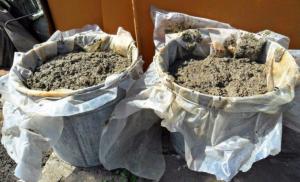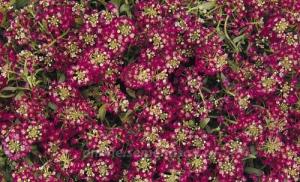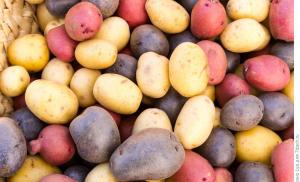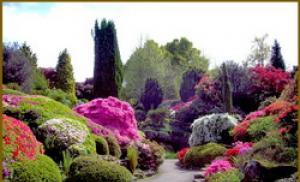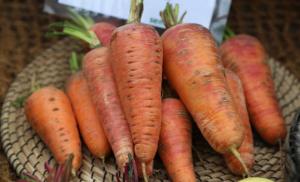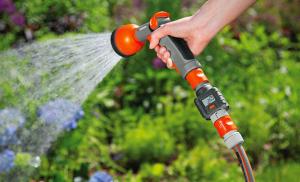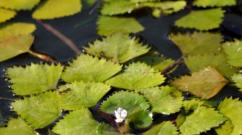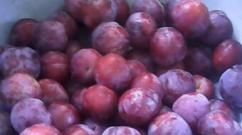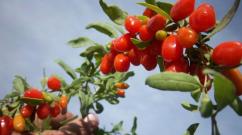Spruce barbel. Black spruce barbel - a pest of coniferous forests Harmful actions and control measures
a- beetle (male); b- doll; v- larva; G- damage
Damages conifers, especially Scotch pine, occasionally spruce, larch, very rarely oak. Intensively inhabits growing, weakened and felled trees, unrooted timber, large felling residues.
Distributed in the European part of Russia, the Caucasus, Siberia and Belarus.
bug black (11-28 mm) with whitish and buffy hairs. The head and chest are rarely punctured. Scutellum triangular, rounded at apex. The median glabrous stripe of the scutellum is wide and short. Elytra with two or three diffuse ocher bands. Legs black, densely covered with fine whitish hairs. The antennae of the male are 2, 3 times, the female - 1, 2 times the length of the body.
Eggs oblong-oval (length 3, 2-4, 5, width about 1 mm). Females lay 1-2 eggs along the entire trunk in incisions gnawed by their jaws. Fertility of one female is about 30 eggs.
Larva whitish, legless (35-40 mm), covered with reddish hairs. The head is shiny. Prothoracic segment with brown shield, dorsal calluses with weak longitudinal notch. The larvae gnaw under the bark on the surface of the sapwood platform-like or on more viable trees ribbon-like passages filled with coarse sawdust.
Chrysalis yellowish-white, antennae coiled, located between the middle and hind legs on the ventral side.
Years beetles from mid-June to September. The beginning of summer coincides with the flowering of linden and hazel. The larvae hatch in mid-July. They feed on bark, bast and sapwood. In early August, they go into deeper layers of wood, making an inlet oval hole with a section of 7x4 mm and a stroke up to 20 cm long.In the process of development, the larvae periodically crawl out of the wood under the bark to feed on bast and sapwood, and the accumulated sawdust is thrown out through the specially gnawed by the larvae hole. Moves in wood, not reaching 1-1.5 cm to the surface, end with an expansion - a doll with a cradle. The larvae hibernate in the pupal cradle.
Pupation in May - June. Young beetles fly out in June-August. The beetle gnaws a round flight hole 5-7 mm in diameter and comes out. They are immature and undergo additional feeding, nibbling the bark of branches and shoots. With severe damage, the branches break off, which leads to thinning of the crown and weakening protective functions tree against stem pests.
Generation one-year-old, but if the conditions for the development of larvae deteriorate, it can take up to two years.
Detailed supervision- by the number of notches (more than 3.1 pcs / dm 2 - the number is high) and flight holes and young beetles (more than 0.8 pcs / dm 2 high population).
Gray long-wattled barbel - Acanthocinus aedilis
a- female; b- the rear end of the male; v- larva; G- pupa in a cocoon
Damages pine, less often spruce and larch. Inhabits the trunks of strongly weakened, dying trees, timber, deadwood, stumps. Environmentally plastic. Dwells in different conditions... It does not bring physiological harm, as it settles on trees that have practically lost their vitality.
Distributed wide. A common inhabitant of pine forests.
bug flat (13-20 mm), light brown, elytra with two narrow dark bands. Pronotum with four felt spots. The abdomen and legs are densely covered with light gray silvery hairs. Male with antennae 2-5 times longer than body length. Female with antennae 1.5 times body length. There is an external, false ovipositor, strongly protruding from under the elytra.
Eggs elongated (length 2.5-3, width 0.75-0.8 mm), light yellow. They are located in the cracks of the bark of the lower part of the trunks of only dying and felled trees.
Larva(30-35 mm) legless, pale yellow, slightly flattened, with sparse fine, light hairs. The upper jaw has a notched apex. The pronotum, divided by a longitudinal pale stripe, has two chitinized yellow spots.
Chrysalis yellowish white (up to 25 mm). Antennae are long, with spines and tubercles. The frons are bordered by a row of setae. Pronotum with prominent lateral angles, bearing transverse rows of spines.
Years begins in April - May, stretches, lasts until autumn. The larvae gnaw wide under the bark, irregular shape passages, slightly touching the sapwood and strongly corroding the subcrustal space (in the bast and cambia). Before pupation, the larvae that give females go into the wood to a depth of 1 cm and pupate in a short hooked course. The larva seals the exit hole with large sawdust so carefully that it becomes almost invisible. Larvae giving males pupate in oval cradles under the bark or in the thickness of the bark itself.
Control Federal Service on veterinary and phytosanitary supervision in the Chuvash Republic informs that during the control quarantine phytosanitary survey of forest plantations on the lands of the forest fund, in the 1st allotment of block 99 of the Novovyslinsky district forestry of the State Institution "Ibresinskoye lesnichestvo", a focus of quarantine harmful organism- black pine barbel (Monochamus galloprovincialis Oliv.) On the square14.8 hectares.
In order to prevent further spread, localization and elimination of outbreaks of the black pine barbel, by order of the Office for the Chuvash Republic No. 93 dated August 01, 2011, a quarantine phytosanitary zone and a quarantine phytosanitary regime were established on the territory of the Ibresinskoye forestry state institution of the Ibresinsky district of the Chuvash Republic for the black pine barbel (Monprochamus gallovinocialis Oliv.) In the outbreak and controlled area (buffer zone) of possible pest detection woodland with a total area of 5954 hectares (based on the biological characteristics of the pest) within the boundaries of quarters No. blocks No. 2 to 7, 9 to 14 of the Karmalinsky district forestry of the Ibresinskoye lesnichestvo, located at the address: Chuvash Republic, Ibresinsky district, Ibresi village, Lesprokhoznaya street. 11.
Black Pine Barbel (Monochamus galloprovincialis Oliv.) Belongs to forest pests of quarantine importance for Russian Federation and importing countries of Russian timber. This pest is included in Section II of Quarantine Objects, which are restrictedly distributed in the territory of the Russian Federation, "The List of Quarantine Objects (Plant Pests, Plant and Plant Disease Pathogens (Weeds))", approved by order of the Ministry Agriculture Russian Federation dated December 26, 2007 No. 673 (registered by the Ministry of Justice on January 17, 2008 under No. 10903).
Black pine barbel (Monochamus galloprovincialis Oliv.) Refers to pests of unrooted softwood... This is one of the most dangerous technical pests that damage various conifers. Body length 15-25 mm. The female differs from the male in more variegated elytra and variegated antennae. Years of beetles occur throughout the growing season.
This pest actively inhabits weakened but viable pines, less often spruce, fir, larch, as well as windblow, large felling residues, unbarked timber. Beetles gnaw the thin bark of healthy pine branches, thereby significantly weakening them. The larvae gnaw passages into the sapwood, filling them with coarse sawdust, then go deeper into the wood, gnawing passages up to 20 cm long.The main danger is that the black pine barbel is a carrier of a dangerous pest of pine stem nematode forests - a quarantine object not registered on the territory of the Russian Federation ...
Having multiplied in unrooted wood, pests pose a real threat to the surrounding forests, since, having received favorable conditions for reproduction under the bark of stored wood, insects switch to nearby trees.
The main measures for the localization and elimination of foci of forest quarantine organisms are the implementation of regular cleaning of storage sites, processing, shipment of timber from needles, branches, bark and wood residues. Avoiding congestion similar waste on the territory of the enterprise. In accordance with the Decree of the Government of the Russian Federation dated June 29, 2007, No. 414 ("Sanitary safety rules in forests"), timely sanitary felling, cleaning of felling residues. debarking) or pesticide treatment.
To avoid the spread of longhorn beetles of the genus Monochamus spp. export of regulated products from the quarantine phytosanitary zone by road and rail is carried out accompanied by quarantine phytosanitary documentation.
Failure to comply with restrictions on the export and use of forest products produced in the quarantine phytosanitary zone may lead to the spread of the black pine barbel throughout the territory of the Republic and, as a result, to death. forest plantations and significant economic damage.
Failure to comply with the established requirements entails bringing to administrative responsibility.
The black pine barbel is one of the most dangerous pests pests of coniferous wood on the territory of the Russian Federation.
Its larvae feed on wood conifers, most often Scots pine. The barbel prefers felled, fallen and weakened trees, very rarely attacks healthy ones. Beetle larvae can damage timber up to practical uselessness. Most often, infected wood has to be burned. In unbarked logs, the larvae make deep tunnels, which affects the quality of the timber.
Biology
The black pine barbel is a beetle with a length of 14 - 25 mm. The flight of beetles begins in the first ten days of June; at the beginning of July, 90% of them leave the wood. Beetles hatch immature and undergo additional feeding for 1-2 weeks in the crown of healthy trees. At the same time, young beetles gnaw the bark of branches of growing pines, often ringing them completely and thereby causing them to dry out, which leads to the weakening of healthy trees. Beetles live up to 70 days, but after 5-7 days, females begin to lay eggs in notches specially gnawed on the bark. The larvae appear in mid-July. They feed on bast and sapwood, gnawing out an irregularly shaped area, and in August they go deeper into the wood, gnawing a vertical brace-shaped passage in it, ending in a doll's cradle at the surface. There the larva hibernates, pupating in the spring. Like other species of the genus Monochamus, the larvae periodically crawl out of the passages into the subcrustal space throughout their development to feed on bast and sapwood. In this regard, they clean and widen their passages, and sometimes make additional holes to eject drilling flour in the form of rather large wood shavings. The end of the stroke in the wood does not bring the larva by 1-1.5 cm to the surface and at the end of it it suits the cradle, where it hibernates. Pupation occurs in May. Generation 1-3 years, depending on the conditions of development.

Pine black barbel. 1 - beetle, 2 - larva, 3 - larval passages under bark and in wood, 4 - pine branch damaged by beetles.
Longhorn beetles are photophilous and prefer sparse, well-warmed plantings. In mixed plantations, the number of barbel drops sharply. It settles along the entire trunk, while in the butt part there are more females, and in the upper part - males.
Symptoms of defeat
When feeding under the bark, the larva makes winding passages that are imprinted on the sapwood. The stroke length under the bark can reach 17 cm, and the width is 3 cm, in wood - 15-20 cm.The colonization of wood by barbel can be determined by the presence of round or elliptical holes more than 3 mm in diameter, as well as the presence of drill meal at the hole, formed as a result insect feeding. In spring, as a result of additional feeding of beetles on young twigs, notches or rings are formed. Damaged shoots break off easily.
The black pine barbel (Monochamus galloprovincialis) lives in the forest and steppe forests of Europe, Siberia, Asia Minor, the Caucasus, as well as in the northern regions of Africa, Turkey, Mongolia and Kazakhstan. Insect activity begins by mid-June and continues throughout July. Life cycle arthropod is 1-2 years old.
Description of Black Pine Barbel
The adult beetle has a thick body, the length of which ranges from 11 to 28 mm. The color is characterized by a bronze sheen, black and brown colors. On the flat short elytra there are hair spots with gray, white, red or yellow bristles. The pronotum is transverse in females, and oblong in males. Up to the middle of the carapace of the arthropod, there is a wide naked stripe. The scutellum can be either whitish or yellow or rusty yellow.
On the abdomen of the beetle there are corns with lateral granules, on which there are single microspines (up to 60 pieces). Reddish hairs grow on the head. On inside there is a spiny tubercle near the long antennae. There is a narrow longitudinal depression in the middle of the head. The eyes of the insect are wide and globular, large size... Coarse brown setae grow on middle tibia. The underside of the body is protected by a reddish-bronze hairline.
The black pine barbel is extremely light-requiring. The beetle prefers to settle in sparse areas with well-warmed plantings. In forests where, in addition to conifers, there are other trees, the number of the pest is noticeably lower. According to the observations of biologists, adult beetles inhabit the entire trunk, but males usually live on the top, and females in the butt.
The appearance of the larvae
The egg of the future insect has an elongated shape. white, which tapers slightly towards the caudal pole and becomes narrowly rounded. The outer shell of the embryo is strewn with small deep cells. The chorion width is 1.4 mm, while the length is 3.5 mm.

The body of the larva is covered with sparse short bristles. Half of the head is still retracted into the front of the chest, on its edge there is a wide band of black color. The color of the temporoparietal lobe is brown, and at the forehead it becomes white. The eyes are located on either side of the head. Respiratory organs have an oval shape without edge chambers. Tergite of meso- and metathorax covered with barely noticeable spines. The length of the black barbel larva is about 45 mm.
Beetle pupa
At this stage, the body becomes quite wide. The head has a longitudinal groove in the region of the crown and forehead. Near clypeus, six spines form a transverse row, which is widely interrupted in the middle. The second half of the antennae in the females of the black pine barbel is twisted in two turns, and in the males in three.
A large conical tubercle is visible on the sides of the transverse pronotum. Moderately protruding mesoscutum is characterized by a slightly extended scutellum toward the posterior margin. In addition, this part of the pupa's body contains sharp spines that form two stripes and diverge from the base of the carapace to the elytra. The elongated abdomen tapers towards the apex of the IV segment. A large cone-shaped urogomphalic outgrowth is closed with a sharp spine. The length of the pupa is 16 to 22 mm.
Insect development at all stages
Embryo formation lasts 13-29 days. By mid-July, the eggs have time to turn into larvae. They feed on the bark, thereby moving towards the woody layers. After 25-45 days, the larvae are already deep enough in the tree. On this one they often crawl out into the subcrustal area of the plant and eat sapwood and bast. At this time, dust accumulates in the damaged trunk. The larvae overwinter in tree passages, which do not reach the surface by 1-1.5 cm.

Pupation occurs in 15-25 days. An adult black pine barbel gnaws a flight hole in a tree and comes out. Pests settle in trees weakened for some reason, fresh windblows and sawn trunks. The beetle uses them as shelter and gnaws at those viable pines that grow in steppe forests. It is noticed that the black pine barbel, the photo of which is posted in this article, does not breed and does not settle in stumps.
Harm and ways to fight
The beetle feeds on conifers, especially pine and spruce. This served as the introduction of the insect into the biological group. During ripening, barbel beetles gnaw on the bark of the pine. The larvae destroy wood, bast and sapwood. The result of the life of the black pine barbel is the weakening and subsequent drying of the tree. Larvae damage untreated wood, reduce technical suitability, thereby undermining forestry. TO biological methods extermination of beetles refers to the attraction of birds that feed on insects.

According to sanitary regulations, there are the following methods of struggle:
- timely implementation of selective and clear cuttings;
- immediate cleaning of the places where the work was carried out, namely, the removal and debarking of the material;
- systematic sampling of dead and dead forests.
This type of insect lives in European countries: from Switzerland, France, northern regions of Italy and Romania to Ukraine. The beetle can be found on the territory of conifers. They prefer to live in mountains, windbreaks and clearings. Adult longhorn beetles feed on the roots and bast of young branches of spruce, pine, fir and other conifers. Arthropod activity lasts from the second part of June to September.

The body of the spruce barbel has the shape of a black cylinder, the length of which in the mature state is 15-37 mm. On the elytra of females, you can see light spots where hairs grow. The pronotum has a sharp tubercle. The tips of the elytra are not characterized by dense hairy pubescence. The scutellum is covered with bristles, including the midline. The antennae of the female are slightly wrapped behind the elytra and have light rings. In the male, they are twice the length of his body.
Black pine barbel- this representative of insects has a dark color (brown or black), with a bronze sheen on light hairs of red, gray or yellow color... On the elytra of this beetle, the hairs are often collected in a pile and form spots with indistinct bands. In males, the whiskers are most often 2 times longer than the body itself, and are black, in females, these antennae are variegated, and rise above the elytra with several apical segments. The wings of the beetle do not have a special bend in the central part of the wings. In the anterior part, the wings have a coarse granular dotted color, and closer to the posterior part the punctures are weakened. The beetle has a wide shield that is covered with hairline dark yellow, divided by a longitudinal furrow to the middle. Pine barbel larvae are white and have no legs. Their length reaches 4 cm. The larva moves due to the transverse row of corns. The spiracles of the larvae are small, light yellow in color.
The flight of beetles can be observed from June to August, and up to September. Pregnant females lay one or two eggs in tunnels cut by them in the bark layer. After about two weeks, embryos hatch from the eggs laid by them, which immediately begin to eat wood, gnawing at the same time in the layer of bark and crown of the passage. They spend the winter at the end of the path they gnawed out. Until the summer of the new year, in the place of their wintering, the larvae become pupae, but already in June - August they become young males. Judging from the name of the species, this black pine barbel settles most often in pine trees, but there are exceptions when they settle in spruce, larch or even cedar.
Beetle behavior
When flying begins, insects additionally feed in the crown of pine trees, eating at the same time the bark of thin branches. After that, the damaged branches break when strong gusts wind. The females of black pine barbel, eat out tunnels in the bark of trees, where they lay a couple of eggs. Often, these grooves are not deep - up to 2 millimeters, if the bark of the tree is thin - shallow, but long (3-5 mm), if the bark of the tree is thicker, then the shape of the groove will resemble a funnel. One female can lay up to 30 eggs. When the larvae hatch, they eat out small planes of uneven shape in the bark, and after a month they gnaw through tunnels oval deeper into the wood. On standing trees, the larvae gnaw through the course first towards the center of the tree, then upward, and after some distance again turns sideways, approaching a less dense layer of wood, approximately 1 cm deep. The length of such a stroke is most often no more than 30 cm. In recumbent trees, if the trunk of the tree does not exceed 20 cm, the stroke can pass through the center, but if the trunk is thicker, the stroke has an arched shape. The hatched young beetles gnaw out a passage 5-7 mm in diameter.
The harm caused
When feeding, the beetles severely damage the branches of the tree in the crown, which contributes to its weakening, and in the future, the weakened tree becomes an object of settlement for longhorns. Unfortunately, the trees in which the longhorns have settled often die. If a tree becomes an object of settlement for longhorn beetles, then these beetles may well "kill" a viable tree. Great importance this beetle has on burnt areas of the forest, because they further accelerate the death, and so damaged trees... Also, larval passages constantly spoil future logging materials. Inhabits pine barbel in the European part of Russia, and adjacent territories such as Kazakhstan, Ukraine and Siberia. The species of beetles is not picky about the weather conditions and the age of trees. They inhabit any trees, whether they are felled, broken by the wind, unprocessed timber, and even the remnants after cutting. They inhabit the thick and transitional bark of the tree. Those beetles that live in middle lane, have a development period of one year, those who live a little to the north - two years. The estimation of the number of beetles is carried out when young beetles crawl out of their holes (June - July). Signs that the tree is inhabited by barbel are the appearance of the presence of insects, as well as notches. A more detailed calculation is carried out on the model trees of the different types and age, by using special equipment according to a certain method.
Fighting beetles
The only correct method of control is sanitary felling of trees. Considering how they live and reproduce black pine barbel, it is best to carry out such a felling in winter. If reproduction has reached its peak, trapping trees should be laid out in the forest. Sprinkle these trees before the larvae enter the wood. If the necessary wood remains in the forest, sprinkling or chemical protection should be carried out.
